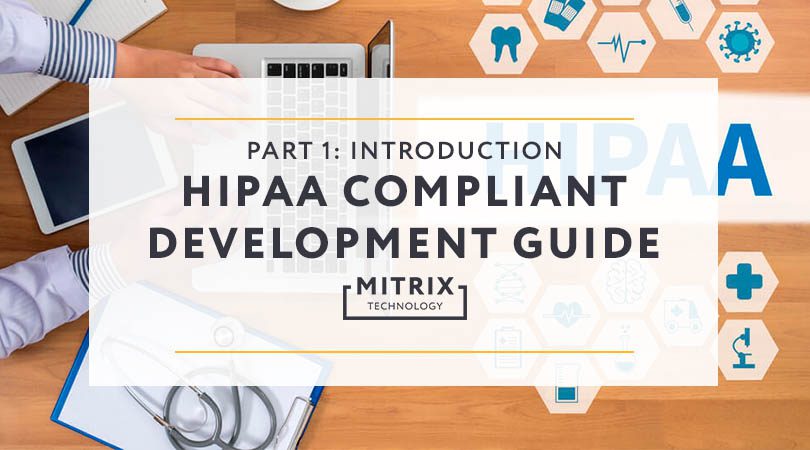
IT has offered plenty of fast, reliable, and cost-effective solutions for a wide range of industries and business application modernization; and the medical field has not been left behind in the frenzy.
According to Healthcare IT News, the annual growth rate of IT applications in the medical field is 7.4%. One of the most significant reasons for this growth is the convenience offered by Computer Physician Order Entry solutions.
When creating healthcare software, development solutions, it is incredibly vital that you adhere to the strict HIPAA/HITECH code. Medical facilities are now looking to hire web developers who are HIPAA-compliant. This article is a guide on how to provide HIPAA-compliant IT solutions for medical organizations.
The HIPAA (Health Insurance Portability and Accountability Act) law was passed in 1996 to ensure that healthcare professionals adequately protect patients’ medical information, otherwise called PHI (Protected Health Information). HITECH is an update of the HIPAA regulations that covers the electronic aspect of medical records processing and transfer.
HIPAA mainly consists of two major aspects: Privacy rules and Security rules. The privacy rule defines PHI as any individually identifiable medical information transmitted through any medium. Any entity that deals in the storage or distribution of PHI, including the medical institution, individual care providers, and software developers is liable in the case of a data breach. Firms that are subject to HIPAA include:
The security rule clarifies the guidelines for ensuring PHI security. It breaks down the security requirements into three major categories:
The necessary features for HIPAA-compliant software in a nutshell include:
The first, and most vital aspect of any HIPAA-compliant IT solution is robust security. Data security is critical in enterprise application development in the medical industry. While it may be impossible to rule out every possible threat, the software or website should have measures in place to protect medical data at all costs. The software should block access to medical data by use of portable media devices and detect any unusual activity.
Healthcare providers are required by HIPAA to perform routine checks of their IT systems to identify and solve all possible PHI data leaks or privacy breaches. HIPAA-compliant software applications and sites use these audits to offer accurate and reliable information for the remedying of identified issues.
A robust plan is required to guide the correction and avoidance of any observed security problems in the future. It is a HIPAA requirement to include these plans in the software. In addition to the software’s inbuilt plan, the medical institution itself should have a robust recovery plan that is specific to its own IT systems.
Most IT solutions in the medical field are used to store, display, and organize documents, which is why a specific set of principles is crucial in the protection of electronic PHI. Such principles may include:
HIPAA-compliant software should also cater to the medical institution’s interactions with the business partners, especially those supplying the IT solutions running the ePHI. There should be a system in place that monitors the business agreement execution, which is regulated by the HIPAA omnibus rule. This rule ensures that the institutions ensure patient record confidentiality as they entrust the business partners with the software managing it.
As seen above, you as the business associate tasked with providing the medical facility with the IT software are just as liable in the case of a data breach. It is therefore vital that you go through the specifications of your application to determine whether its use warrants the handling and storage of PHI. Consider having a qualified security specialist comb through your application architecture for potential loopholes to ensure compliance with the security requirements. There are also other laws that will come into play in determining your application’s design’s compliance, which you should go through.
Request, display, and store personal information from your clients that is absolutely necessary. Any information you have, including birth dates, should have a clearly defined purpose. Another kind of data that developers often ignore is geolocation. HIPAA guidance stipulates that information regarding someone’s location in a subdivision smaller than a state will identify them, thus turning geolocation data into PHI.
If your mobile app collects personal data from its users, ensure that there is a privacy policy that clearly outlines the nature of the information they will input.
One of the ways to ensure that you avoid data security issues is by not storing or caching it at all. The use of Flash storage is not entirely reliable as the data set to be deleted may not actually be safely removed. However, if you plan to use cloud storage, ensure that the mode of transmission is secure.
When providing an encryption tool for medical data, use widely tested and approved protocols rather than your own code. Also, consider the App Transport Security system for your mobile app; this feature facilitates the secure transmission of data via HTTPS to ensure the encryption of data in transit. Again, when sending texts, Push, and MMS notifications, ensure they do not contain any PHI as these are rarely encrypted. After long periods of inactivity, have a feature that ensures re-authentication.
Medical Records Confidentiality is exceedingly vital to ensure the quality of healthcare and the privacy of patients. There are many tools that make HIPAA compliance relatively easier and avoid the chaos and aftermath of potential lawsuits that often run into millions of dollars. Mitrix Technology team can help you to develop HIPAA compliance solutions. We have been working on it for more than 5 years and have a great experience in the medical software development.

Learn how Mitrix Technology composes the best teams to design intuitive and visually consistent e-learning solutions.

Mitrix Technology shares its proven record of delivering school and learning management software for a Swiss private school.